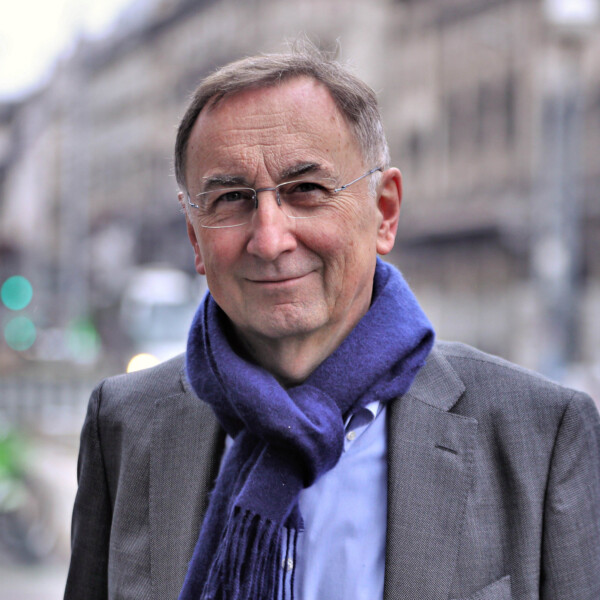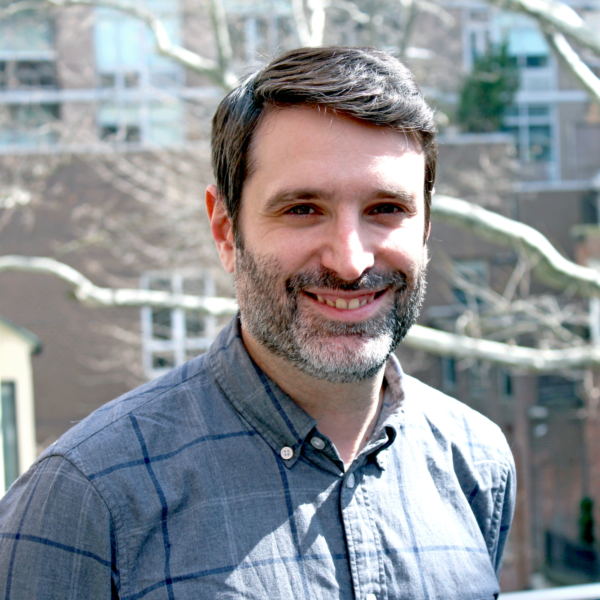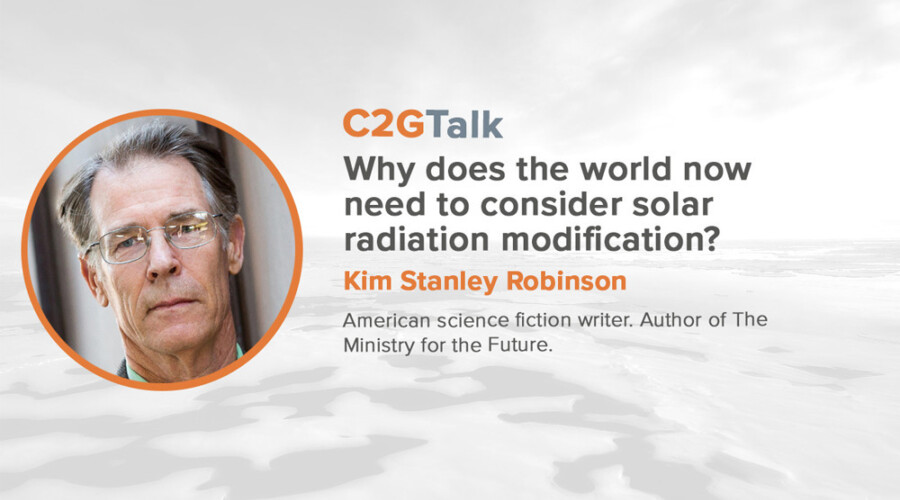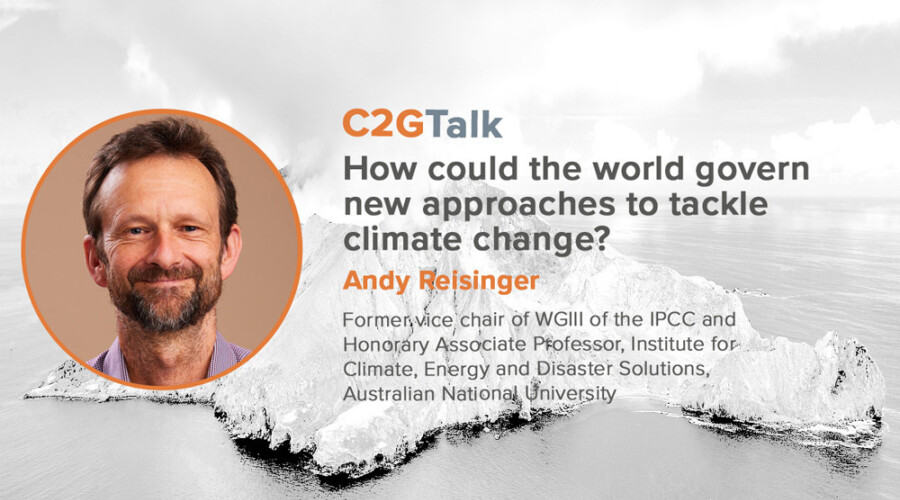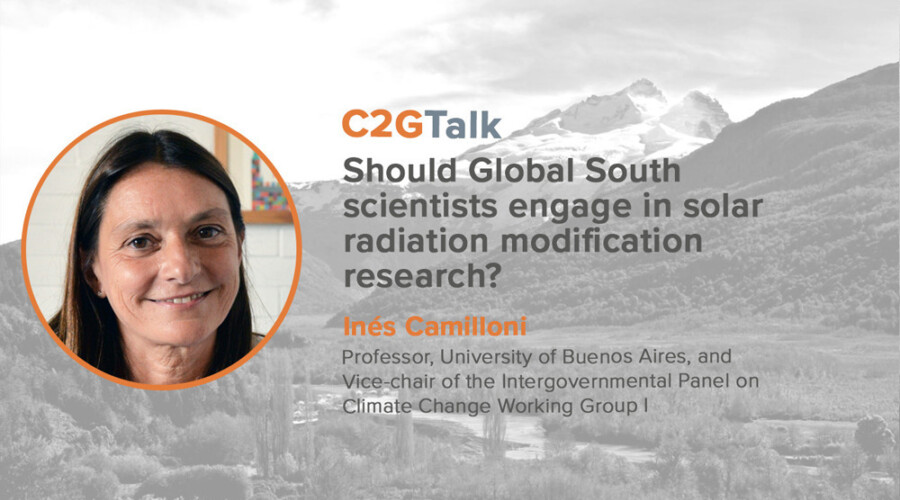Janos Pasztor, executive director of the Carnegie Climate Governance Initiative (C2G), gives an update on his team's work after a busy week in New York. In the wake of troubling IPCC reports on climate change's effect on the oceans and land use, what more can the UN do? What are the challenges of nature-based solutions? And how should we handle climate change fatigue, individually and on a societal level?
ALEX WOODSON: Welcome to Global Ethics Weekly. I'm Alex Woodson from Carnegie Council in New York City.
This week, we'll be posting two podcasts on climate change that we recorded last week. Later in the week, you'll hear my talk with Stephen Gardiner, professor of philosophy at the University of Washington. We spoke about a few of the many ethical issues surrounding climate change.
But first, I spoke with Janos Pasztor, Carnegie Council senior fellow and executive director of the Carnegie Climate Governance Initiative or C2G.
C2G seeks to catalyze the creation of effective and inclusive governance for emerging climate technologies, in particular, for solar radiation modification and large-scale carbon dioxide removal. They are focused on expanding the conversation from the scientific and research community to the global policymaking arena. C2G is impartial regarding the research, testing, or potential use of any proposed technologies or interventions—these are choices for society to make.
Janos was in New York last week for the UN General Assembly and Climate Week. We spoke about the role of the UN in his work and climate change more generally, governance challenges relating to nature-based solutions, and how to deal with climate change fatigue.
For more from Janos, you can go to C2G2.net or CarnegieCouncil.org, where you'll find an interview that I did with Janos about a year ago and his talk with journalist Stephanie Sy from 2016.
But for now, here's my latest talk with Janos Pasztor.
Thank you so much for coming today. Great to see you again.
JANOS PASZTOR: You're welcome.
ALEX WOODSON: You and the C2G team are here in New York for the UN General Assembly (UNGA) and for Climate Week. What are some of the things that you've been up to this week?
JANOS PASZTOR: Quite a few of us from the team are here. We had a whole series of activities, some linked specifically to the UN General Assembly, others to Climate Week in New York. They included organized events, where we would convene, a whole series of bilateral events, and also speaking at different events. Between the four of us who have been around, we were quite engaged in all these different things.
ALEX WOODSON: What has the reception been to C2G this year? It has been a few years now that you've been coming to the UN General Assembly representing C2G. Has the reception changed over the years? Have the conversations shifted?
JANOS PASZTOR: Let's be very clear that while we have been active on the margins of the UN General Assembly, we don't have an official function in the General Assembly. What I can say is—individual governments and their representatives when we talk to them—how they react to our activities, and how some of the other non-state actors react.
I think it's fair to say that over the last year or two there has been an evolution, and increasingly the stakeholders that we speak to say that what we're doing is really necessary, it's urgent, and they invite us to meetings. They take seriously what we're saying; they're listening to us. That's very helpful feedback for our work.
Even before coming to the GA, I was traveling and meeting government officials in different countries. In a number of places I hear that, for example, the catalytic work that we did earlier this year in the UN Environment Assembly is what triggered their government to actually start thinking about strategies toward these technologies. That means we're effective, and people are listening and talking to us.
ALEX WOODSON: Is there something that you've noticed was a turning point over the last few years, or has it just been more gradual?
JANOS PASZTOR: There are a few turning points. One of them was the Special Report of the Intergovernmental Panel on Climate Change (IPCC) on the 1.5-degree goal. What was significant in that report is that—although we knew this information before, but it was expressed in a way that it is now much clearer than before—all the pathways that the Intergovernmental Panel could envisage in terms of emission reductions and reaching the goals, all of them which keep us below 1.5 degrees, require large-scale carbon dioxide removal. In other words, you can't do without it.
That was significant for us, because from that point on it's no longer the question of whether or not, the question is more like, which technology, who pays, when do you start, how do you consider the impacts, how do you consider the trans-boundary issues, how do you measure, monitor, and account for these changes that are going to take place? It puts the world, and therefore, our work, into a completely different perspective. That's one milestone.
I think the second milestone happened here this week at the UN General Assembly, where I think now the number is 77—and maybe more by the time we speak now—countries that have come forward and committed themselves to a net zero emission scenario by 2050. Net zero emissions by 2050 is basically impossible without large-scale carbon dioxide removal of some kind.
Again, which technology, and whether you used nature-based or technology-based, that's another question, but the fact is that 77 countries are now forming a group of countries that will have to do something about these issues, and therefore the issues we have been talking about will become very relevant.
ALEX WOODSON: There was also an IPCC report this week that came out about warming oceans. What was the reaction among C2G to this report? I assume this is a lot of stuff that you already know, but is there anything new in there that maybe changes your thinking or pushes you a little more?
JANOS PASZTOR: You're right. In fact, there were two very important special reports by the IPCC. There was one on land that came out a little bit earlier, and this week the official publication of the ocean and cryosphere. It's the ocean and the ice, in glaciers, Antarctica, and Arctic regions as well.
Both of these reports are quite significant for our work. There is nothing really new in either of these. Most of those issues were addressed in previous IPCC reports, but what is new is the depth of analysis and increasing certainty about certain issues that are taking place.
There are some new elements, but fundamentally we know, and what comes out which is really important for us is that in all these cases, what is key is the governance because if you govern, for example, nature-based solutions—well, let's just say ocean-nature-based, because there are some of those—if you govern them well, then it should be possible to remove carbon, increase biodiversity, and not have major impacts. But if you govern them badly, then all those things might happen.
It's this fundamental issue that these issues are linked—climate, land, ocean—and we need to find good governance structures to make sure that those linkages are realized. That is to say we encourage as much as possible the synergies between these and discourage as much as possible the tradeoffs.
ALEX WOODSON: You mentioned nature-based solutions. There is also a policy brief that was posted on the C2G website recently about nature-based solutions. These include methods like large-scale planting of forests and restoring wetlands. As you said, if they're not governed correctly—maybe we'll just take these two examples—there could be big issues. What are some of the challenges in governance with these types of solutions?
JANOS PASZTOR: Nature-based solutions are a particular set of issues where you really link the objectives for climate change, which is the carbon, the objectives for biodiversity, which is the reduction of species loss and extinction, increasing biodiversity, and also the production of food. If you're not careful, if your governance framework is not good enough, then you will look at, in a silo, one or two of these aspects but not the totality.
A concrete example, one scenario for carbon removal is called "bio-energy with carbon capture and storage." It's a very complicated name. It has an even worse acronym, BECCS. The basic idea is simple: You grow large amounts of biomass, like trees or sugarcane or whatever you want to do, and then you take that and burn it to produce electricity, and on-site you capture the carbon through chemical means and then convert it into some solid or liquid, and then you dispose of it, either in a mine or under the sea. There are different ways of doing so. Thereby, you have a net-negative technology in terms of emissions because you absorb carbon with the growth of the tree, and you immediately capture upon conduction, and you put it away, so you're basically producing energy and fixing carbon.
The challenge with this is you need very large quantities of land to produce all that biomass, and if that land takes away land that would have been producing food, that will produce price rises in food, which the poor will suffer from. The large-scale plantations will require pesticides and water use, and very often large-scale plantations tend to be monoculture, and that reduces biodiversity. So, you see the huge set of challenges that a technology like that can cause.
You can try to govern it and try to bring together the different objectives, so maybe not set up a monoculture but different species of trees. Then, immediately it looks different. Maybe you engage the local farmers and do some kind of agroforestry schemes, so there is also food production. There are different ways to solve the problem, but they all require governance.
ALEX WOODSON: Part of evidence brief on the website dealt with how these nature-based solutions interact with the Sustainable Development Goals so that process is moving along as C2G is doing its work and having these conversations. How do these nature-based solutions interact with these Sustainable Development Goals? Do they make some of them harder to reach? Do they complement them in some ways as well?
JANOS PASZTOR: We commissioned a paper last year on exactly how this works, and we looked through both the carbon dioxide removal technologies and the solar radiation modification technologies. We looked at each of them and compared them to their Sustainable Development Goals and had kind of a traffic-light matrix—red, white, green—is there a positive impact? Is there a negative impact? Do we know enough to take policy decisions, or do we need to do more research?
We basically did an initial assessment like this, and, as you would expect, there are some positive impacts, and there are some negative impacts. That's where the whole idea comes that we need to find ways to increase the synergy and decrease the tradeoffs to the extent that we can.
For example, some of these nature-based solutions are particularly interesting because if you increase the organic content of the soil, then of course you're storing carbon in the soil. At the same time, it's good for agriculture, which means it will be better for food production and maybe for the livelihoods of people.
So, suddenly you're addressing a number of Sustainable Development Goals, like poverty eradication, food security, and carbon. That's the idea of this paper, and we hope that further work will be triggered by this initial analysis where maybe more research is required, and maybe it will help also policy people to put together policies that maximize the synergies.
ALEX WOODSON: I want to look a little bigger-picture at climate change in the United Nations and all those issues. We're almost four years after the conference that led to the Paris Agreement. You mentioned some 77 nations have agreed to net zero emissions.
Looking back over four years, is this progress that you and your team are happy with, or would you have expected more to come of the Paris Agreement after this time?
JANOS PASZTOR: We are clearly not there yet. That's the bottom line.
What has happened now is that 77 countries have agreed—they've committed themselves—to reach net zero by 2050, which is one thing we need to do. But 2050 is still 31 years from now, and there are actions that countries need to take now. So, there is a lot between now and 2050.
Of course, a lot needs to be started now in order to be able to reach net zero by then, but we also need to simply accelerate emission reductions because what again the Intergovernmental Panel on Climate Change is telling us, the latest science, is that emissions globally should be already reducing substantially—because currently global emissions are still going up. We have about a decade or so to really radically change this direction and bring the emissions down. Otherwise, we will miss the opportunity to remain below 1.5 degrees, whatever else we might do.
It's good that countries have their long-term, mid-century strategy plans. That's good, but we also need much more ambitious immediate actions. What one hopes to have—not just one hopes, but as part of the Paris Agreement—every five years the contracting parties, the governments, have to come back with new plans for climate action, the so-called nationally determined contributions (NDCs), and next year is the time when the next set of NDCs is due. That will be the first important milestone in terms of being able to judge whether the Paris Agreement is on a successful path.
We always knew that the existing actions that countries have would not be enough. The current actions would take us to about 3 degrees or more above historical average, and we need to remain below 1.5, so we know we have a long way to go. The question is the next set of NDCs that will appear at the end of next year: Will they be sufficiently ambitious to make that change? That's when we will be able to begin to judge the success of the Paris Agreement.
ALEX WOODSON: This is similar to a question I asked when we spoke about a year ago. It's one that I don't like asking, but we're still faced with a situation where there's a very unhelpful administration in the White House in the United States in terms of climate change. How does that make your work harder? How does that make your work more challenging, when the United States is not a helpful partner in this?
I guess you can add Brazil to that, too. Bolsonaro has not been helpful as far as climate change, as far as I can see. Those are two huge countries that really aren't on the same page as a lot of other countries in the world.
JANOS PASZTOR: As I mentioned earlier, the current plans of countries, if they are 100 percent implemented, will take us to about 3 degrees still, and we need to go way beyond that. If some of the major countries, the major emitters—like the United States, like Brazil, and maybe others too—are not going to do what they had committed to, then temperature increase will be even higher.
Of course, there are different ways that different countries can put policies in place. It's not our job at C2G to say that the United States is right or wrong, or Brazil is right or wrong. There are different ways of solving the problem, but if the outcome is an increase in emissions, then that's bad, and that is what is happening right now. That is something that is not helpful to our work in the sense that the less we reduce global emissions, the more carbon will have to be removed if we want to stay below the 1.5 degrees.
Put another way, if the emissions continue to rise, not only will we need to remove more carbon, but we'll have probably a higher level of adaptation that will be required, and you can't adapt to 4-5 degrees above historical average. It becomes uncharted territory, so the challenge is just going to be much harder. In that sense, it's unhelpful.
At the same time, the more the global emissions remain high, the more people begin to think, Oh, wow! We may need to do additional actions, which is, in a sense, what we've been saying all along. Governments and non-state actors need to reflect that the current state of emissions and the current efforts and ambition level of the countries means that there is likely to be the need for large-scale carbon dioxide removal, and, in order to be able to do that, we have to address the governance issues. That is coming to the forefront, so we're very busy.
ALEX WOODSON: Are you able to have conversations with state and local governments that have been more productive in some of these countries where their federal governments might not be so helpful?
JANOS PASZTOR: We try to do that. That's part of our work, to reach out to countries globally. Of course, we're a small team, and we cannot reach out to 195 countries. We try to engage with countries that matter. That means, of course, size does matter sometimes, but also there are countries that are important because they are holding the presidency of a regional group or of some political group. If the African Union presidency is Rwanda, then, of course, we're interested in Rwanda, even though it's a very small country.
What we try to do is select countries that help us to reach these objectives, and then we engage in discussions at the national level and, where relevant, also at the local level. We have also had some—limited, still—exchanges, for example, with cities. We do believe that cities can be a very important geographical location for action. The same way cities are getting together to address climate change as a whole, we believe that at some point they may be also quite interested in engaging on these emerging climate-altering technologies.
ALEX WOODSON: Just to wrap up, as someone who is immersed in this and leading a team of people who are immersed in this work—we mentioned these IPCC reports that came out. They're very troubling to read and to think about what our future could look like.
I'm sure you've gotten this question before; I'm sure you've discussed it. I've seen the term "climate change fatigue" come up a lot more, people worried and depressed to the point of inaction about climate change. What are your strategies for moving beyond that, for just keeping your eye on the big picture and trying to keep a positive attitude in the face of all this troubling news?
JANOS PASZTOR: First, let's be clear: the news is troubling. I think it's important to recognize that. When I speak at public events, I always make it very clear that we are in a climate crisis. It's really serious.
If you leave it at that, then people get turned off because it's so big and so challenging that they say, "Well, I can't do anything about it, so I might as well just go on, and something might happen."
We can't stop there. When it comes to climate change overall—and I'll come to our specific work later—we know that it's possible to do it differently. We know it's possible to have a low-carbon economy with a high level of services, comfort, food, heating, all those things. It's possible to do it. We have seen countries that were able to double their gross national product and reduce their emissions; it's possible.
How you do that is a complicated set of both bottom-up actions by individuals and top-down actions by governments and the private sector through policies to direct the market to take action, and then things will happen. I think it's important to be clear in our communications that we're in deep crisis, we have a serious problem which we need to address, and if we don't address it that there will be very serious challenges and impacts down the road, and some potentially uncharted territory because we don't really know what will happen if it goes very far.
At the same time, we have to be very clear that it is possible to fix, that there are solutions. Some require technology. Some require thinking about different behaviors and lifestyles, but we do that all the time. The iPhone has completely changed our lifestyle. So, it's not that society cannot change, it's just that we need to think of ways that we help societies to change in the direction of low-carbon lifestyles.
Public transport is comfortable if it's good, efficient, and on time, and it happens to be low-carbon. That's great. Eating healthy is often low-carbon, so maybe eating healthy is a good thing. Let's try to find those things and help society to move into different behaviors and different lifestyles that are perhaps overall better, not just for carbon and not just for climate, but also maybe for biodiversity and other actions.
That's the overall climate. When it comes to the specific concerns of C2G, which is the emerging climate-altering technologies—like carbon dioxide removal, like potentially solar radiation modification—these technologies are things that we would not really want to have to use. Why would anybody want to do that? There are no benefits really other than removing carbon or reducing the temperature.
We might need them. We need some for sure, and we might need some others because of the past accumulation of carbon. We need them to restore, to fix the errors that we have done in the past. There are not too many benefits, so it's more difficult to sell.
In the case of nature-based solutions, it is possible because there are cool benefits. There is, of course, carbon removal, but it can improve agriculture production, and it can do many other things that are good for people. In those areas, it will be easier to get a social license because people will see it easier. In some others, it will be more challenging, and that just increases the work that we have to do—we collectively, the different actors—on communication of why these are necessary and why society needs to actually do them.

